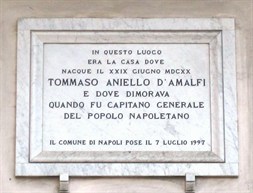Filomarino and the Masaniello revolt
 Cardinal Filomarino’s conduct during the Masaniello revolt (1647-1648) has long been the subject of much debate among the witnesses and protagonists of the event as among historians of later centuries. Many, especially the Viceroy, the Count of Oñate, accused him of having openly sided with the rebels, of having acted to promote the arrival of the French to Naples and, consequently, that he had been unfaithful to his legitimate sovereign, the King of Spain Philip IV. In fact, during the revolt Filomarino maintained a deliberately ambiguous position, actually showing sympathy for the rioters and a lack of consideration for some members of the Spanish power (first of all, for the Viceroy, the Duke of Arcos), but although care was taken to never exceed the boundary of loyalty to the king. He exercised an undoubted influence on Masaniello, and in general his charisma held sway over the leaders of the revolt. He managed to appoint a relative of his, Francesco Filomarino di Roccadaspide, to the strategic position of grassiere of the city (ie the prefect of the Annona) and tried to act as mediator between the rebels and the vice-regal power, attending the swearing in of the Duke of Guisa (blessing his sword), but it is not historically proven that he ever tried, in agreement with Cardinal Mazarin and Pope Innocent X, to impose French rule over southern Italy. He refused to excommunicate the city and to condemn it, as well as strongly disapproving of the bombing of the city wished by Arcos and undertaken by the fleet which arrived in the port of Naples under the command of Don Juan of Austria. Together with the latter and the new Viceroy Oñate, Filomarino crossed the city on horseback on April 6, 1648, to spread the news of the end of the revolt and to push the leaders, above all Gennaro Annese, to surrender peacefully. When the revolt ended, Oñate asked in vain for Filomarino’s removal, who was considered an internal enemy in the Spanish viceroyalty. The cardinal instead remained in Naples until his death in 1666.
Cardinal Filomarino’s conduct during the Masaniello revolt (1647-1648) has long been the subject of much debate among the witnesses and protagonists of the event as among historians of later centuries. Many, especially the Viceroy, the Count of Oñate, accused him of having openly sided with the rebels, of having acted to promote the arrival of the French to Naples and, consequently, that he had been unfaithful to his legitimate sovereign, the King of Spain Philip IV. In fact, during the revolt Filomarino maintained a deliberately ambiguous position, actually showing sympathy for the rioters and a lack of consideration for some members of the Spanish power (first of all, for the Viceroy, the Duke of Arcos), but although care was taken to never exceed the boundary of loyalty to the king. He exercised an undoubted influence on Masaniello, and in general his charisma held sway over the leaders of the revolt. He managed to appoint a relative of his, Francesco Filomarino di Roccadaspide, to the strategic position of grassiere of the city (ie the prefect of the Annona) and tried to act as mediator between the rebels and the vice-regal power, attending the swearing in of the Duke of Guisa (blessing his sword), but it is not historically proven that he ever tried, in agreement with Cardinal Mazarin and Pope Innocent X, to impose French rule over southern Italy. He refused to excommunicate the city and to condemn it, as well as strongly disapproving of the bombing of the city wished by Arcos and undertaken by the fleet which arrived in the port of Naples under the command of Don Juan of Austria. Together with the latter and the new Viceroy Oñate, Filomarino crossed the city on horseback on April 6, 1648, to spread the news of the end of the revolt and to push the leaders, above all Gennaro Annese, to surrender peacefully. When the revolt ended, Oñate asked in vain for Filomarino’s removal, who was considered an internal enemy in the Spanish viceroyalty. The cardinal instead remained in Naples until his death in 1666.
